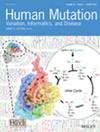REVEL Is Better at Predicting Pathogenicity of Loss-of-Function than Gain-of-Function Variants
Abstract
In silico predictive tools can help determine the pathogenicity of variants. The 2015 American College of Medical Genetics and Genomics (ACMG) guidelines recommended that scores from these tools can be used as supporting evidence of pathogenicity. A subsequent publication by the ClinGen Sequence Variant Interpretation Working Group suggested that high scores from some tools were sufficiently predictive to be used as moderate or strong evidence of pathogenicity. REVEL is a widely used metapredictor that uses the scores of 13 individual in silico tools to calculate the pathogenicity of missense variants. Its ability to predict missense pathogenicity has been assessed extensively; however, no study has previously tested whether its performance is affected by whether the missense variant acts via a loss-of-function (LoF) or gain-of-function (GoF) mechanism. We used a highly curated dataset of 66 confirmed LoF and 65 confirmed GoF variants to evaluate whether this affected the performance of REVEL. 98% of LoF and 100% of GoF variants met the author-recommended REVEL threshold of 0.5 for pathogenicity, while 89% of LoF and 88% of GoF variants exceeded the 0.75 threshold. However, while 55% of LoF variants met the threshold recommended for a REVEL score to count as strong evidence of pathogenicity from the ACMG guidelines (0.932), only 35% of GoF variants met this threshold (P = 0.0352). GoF variants are therefore less likely to receive the highest REVEL scores which would enable the REVEL score to be used as strong evidence of pathogenicity. This has implications for classification with the ACMG guidelines as GoF variants are less likely to meet the criteria for pathogenicity.


 求助内容:
求助内容: 应助结果提醒方式:
应助结果提醒方式:


